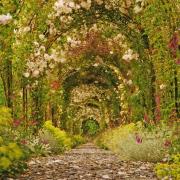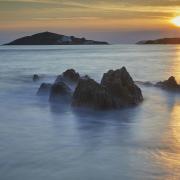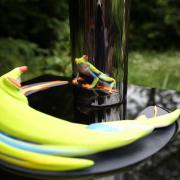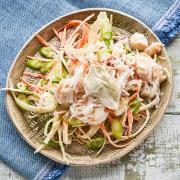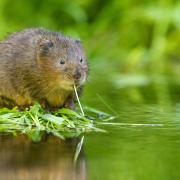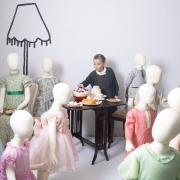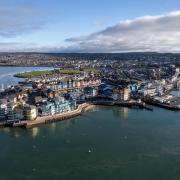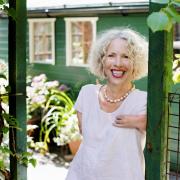Annabel Wigginton suggests 10 nature sights in Devon to enjoy this year.
Across the year, Devon is home to some amazing species. Ranging from the large to the small, they can be a breath taking sight so don't forget your camera.
Glow worms sightings!
Tarka Trail, Yelland
Technically beetles, adult glow-worms are brown in colour and measure up to 22mm. The females are easy to spot, if you know where to look, as give off their distinctive green-yellow glow. This unique glow is used to attract a mate and can be seen after dark from May through to September, peaking in July. Many sightings of these glow worms have been made along the Tarka Trail in Yelland, North Devon, where their preferred habitat appears to be in long grasses and footpath edges. If you fancy it, the whole trail is just over 30 miles and is one of the country’s longest continuous traffic-free walking and cycling paths. Expect beautiful views across the Taw Estuary, quaint café stop off points and finally a deserved breather in the Puffing Billy pub at the former Torrington railway station.
Beavers are back!
River Otter
Beavers are aquatic mammals that can weigh over 25kg; they habitually remain close to a watercourse in search of food, however are strict herbivores and so do not eat fish. Hunted to the point of extinction in the UK in the 16th century, spotting beavers in the wild was a thing of the past. Incredibly and from an unknown source, the first breeding population for several hundred years has now been confirmed in Devon. Beaver activity has been spotted along the 12 mile stretch from Honiton to Budleigh Salterton along the river Otter. There are many footpaths and public rights of way alongside the river which are the best places to go to spot these rare rodents, however beavers can cover large areas so could be anywhere along the river, so be-very patient!

Bee Orchid
Torbay Limestone
This hardy orchid grows to a height of between 15 and 50cm with a hairy median lobe that has a remarkable resemblance to the abdomen of a bumble bee! Their preferred habitats are grasslands, limestone rocks, calcareous dunes or open woodlands. The Bee Orchid self-pollinates in the UK, producing blooms from mid April to July however relies on the assistance of bees in Mediterranean areas. The plant mimics the scent of the female bee whilst its bee-like lobe acts as a decoy, tricking the male bee into pseudo pollination. The male bee then goes on to transfer pollen to another bee orchid which offers the same visual deception. These orchids can be found along Devonian age limestone that Torbay has to offer, particularily around Berry Head. The area has open grassland and broken cliffs to offer; an ideal habitat for the Bee Orchid.

Spot some Seals!
Peartree Point, South Devon coast
Grey seals are social mammals, feeding along South Devon’s coastline in large groups. Male seals can be distinguished by their dark grey/brown coat with lighter coloured spots in contrast to the females which have a lighter coloured coat with a pale chest which is spotted with darker patches. These seals have a distinctive long nose which gives then an almost horse shaped head and are present all year round, with numbers peaking from late August to mid October. A hotspot to see these seals is at Peartree Point along the Start Point coastal walk. The walk is a 2.2 mile circuit, starting and finishing at Start Point car park, TQ7 2ET. Suitable for children, the walk also packs in a beach and lighthouse as well as the beautiful, rugged scenery that surrounds you.
See, or hear rather, the Guillemot breeding colony!
Berry Head
These birds spend most of their life at sea, surviving on fish and crustaceans and only returning to land with the purpose of nesting. Interestingly, rather than building a nest these birds lay a single egg and then take turns to look after it. Guillemots are dark brown and white in colour with a ring of white around their eyes, extending to form a stripe from the outer corner. These birds are vulnerable to oil spills at sea and so are protected by an act of parliament during their breeding season to ensure their survival as a species. The largest nesting colony, of well over 1000 of these birds, along the Channel coast is seen at the cliffs below Berry Head. This is a noisy yet wonderful sight and can be seen best from March through to the End of July.

Seeing red…Deer!
Rackenford and Knowstone Moors
Red deer are Devon’s largest land mammal; they are present all year round though being shy creatures are not always easy to spot. However, the autumn months see a time of the year where these red deer change from their usual state of shy and subdued into one of unrest. This happens as they enter the mating season, which is termed the ‘rut’, and is when they are often a lot more active during daytime hours. The stags can be seen guarding groups of females, boasting their impressive muscular figures with magnificent antlers and ragged manes. The best time of the day to witness this spectacular sight is during the hours of dawn and dusk. Rackenford and Knowstone Moors are easily accessible to the public and are great places to see this wonderful act of nature as well as being home to a variety of other species. These moors are part of the Devon Wildlife Trust Nature Reserve; a mixture of grassland, heathland and bog which cover an extraordinary 120 hectares.
Harbour porpoise
Capstone Point, Ilfracombe
These marine mammals are the smallest cetacean species to be recorded in the UK, with an average size of between 1.4m and 1.9m. In comparison to their dolphin relatives, the Harbour porpoise is a smaller, thicker mammal and with a blunt snout. They are dark grey/brown in colour with a white underside and are typically spotted in more shallow waters close to land. Being shy in nature, these mammals are best seen from land rather than by boat. A large breeding population of Harbour porpoises reside in the South West, and in particular along the North Devon coast. A popular spotting point for these wonderful sea creatures is at Capstone Point, Ilfracombe. Actively preying on small shoaling fish, their activity is often marked by competitive, or rather opportunistic, diving sea birds. You are most likely to spot these mammals between the months of March and April and then between July and November as their production peaks in the spring and autumn seasons.

See moorland Ponies
Dartmoor
A native breed, the Dartmoor Pony has long been celebrated as an integral attraction to the area; attributing towards its character and beauty. Physically, the breed is suitably hardy as to withstand Dartmoor’s harsh weather conditions, though by temperament they are typically gentle and calm. In the past these animals have been used for work, assisting tin miners and even being used by guards at the Dartmoor Prison to escort prisoners. At the present time this breed exists in a semi-feral state, being owned by farmers and protected under the Dartmoor Commoners Act; under which being fed by the public is illegal! Dartmoor ponies aren’t hard to find, with about 5000 spread across the beautiful National Park. However it is recommended to visit between May and August as foals are most commonly born between these months and so if the cute factor is what you are after they win the prize!
Barbie Bats
Various woodlands around Devon
The Barbastelle is one of the rarest and smallest mammals in the UK, usually weighing between 6.0 and 8.5g and with a body length between 4.4 to 5.8cm. This tiny creature has long, silky, dark brown fur which is slightly white at the tips, looking as thought it has received a light dusting of snow! Their ears are distinguishing, being broad and meeting above the head, of which has a short and wide muzzle. These bats are happiest in a habitat that provides them sheltered woodland with space to roost and forage and with water present. Due to their size and nature, spotting a Barbie roosting is very difficult; however is it possible to catch a glimpse of them at dusk. During this time the bats activity is more sporadic, they fly close to bodies of water and over the top of woodland using echolocation techniques to hunt for prey. These bats typically feed on small moths, insects and beetles. Barbies have been spotted at various nature reserves around Devon including: Venn Ottery near the village of Higher Metcombe, Lady’s Wood along the River Avon and Sourton Quarry near Okehampton.

Wood White Butterfly
Meeth Quarry, Hatherleigh
These dainty butterflies are one of the smallest white butterflies found in Britain. With a slow flight, their upperwings are white and with rounded edges with the males having a distinctive black mark on the edge of their forewing. The males are very active during the day, flying almost continuously in search of a mate, whereas the females occupy their time resting and feeding on flowers. These butterflies are most abundant in sheltered environments such as woodlands or edge habitats. Smaller colonies have been regularly spotted in North Devon at Meeth quarry. The quarry is situated along the Tarka Trail and is a conservation site for this breed of butterfly. The Butterfly Conservation trust is holding a Wood White walk on Saturday the 18th July 2015 at 10:30am. Visitors will be shown hotspots for this breed which should by then be in the second brood (generation) for the year. Adults typically emerge from early May and fly until mid-July, however this period can extend until August in certain sites which offer favourable conditions, allowing for a second generation. The walk begins at the main Dorset Wildlife Trust car park (Grid ref: SS 540 085, nearest post code: EX20 3QD) at the end of the private lane off the A386 just south of the village of Meeth (EX20 3EP).




